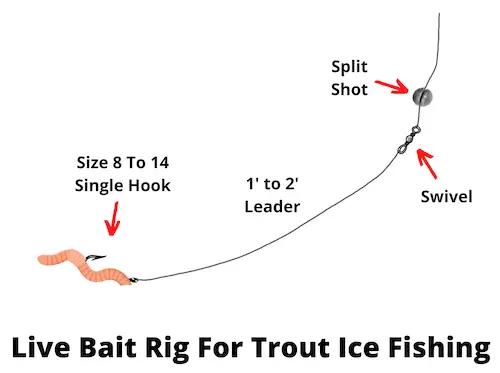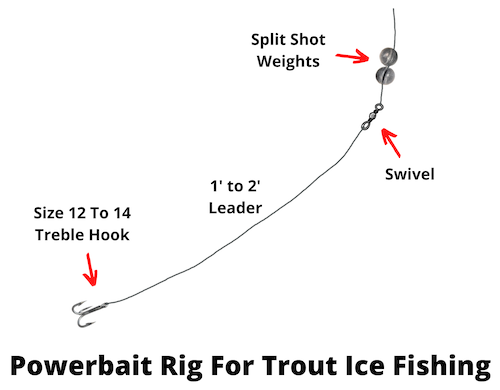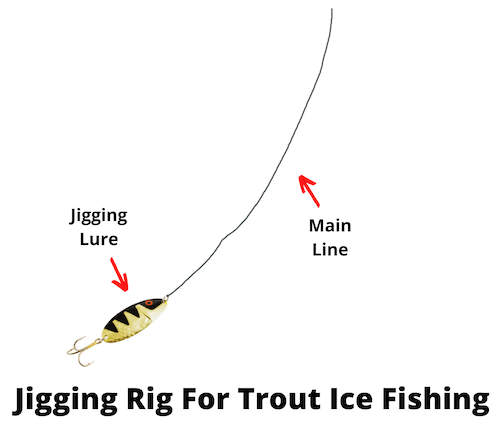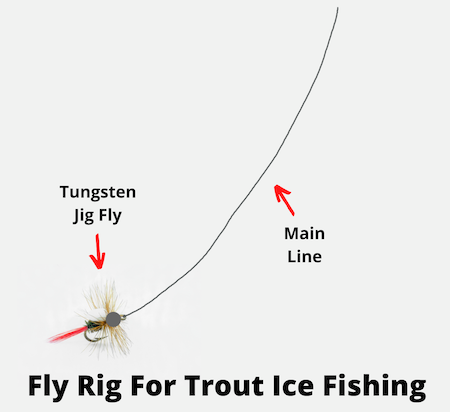Best Trout Rigs For Ice Fishing (Detailed Guide)
UPDATED 18 MAY 2023
by Robert Ceran
As true coldwater fish, trout remain active throughout the whole winter, and feed actively under the ice.
Because of this, they are an excellent species to target with ice fishing, which is probably part of the reason why trout ice fishing has become increasingly popular in recent years.
But if you’re planning to catch these beautiful fish through the ice, it’s essential to use the right ice fishing rigs for trout.

In this article we’ll cover the four most important trout ice fishing rigs, and will also explain when and how to use each of them.
How do you rig for ice fishing trout?
The 4 best ice fishing rigs for trout are:
- Live bait rig
- Powerbait rig
- Jigging rig
- Fly rig
All of these rigs have their own strengths and weaknesses, and all of them come in handy when you’re ice fishing for trout.
So ideally, you should aim to be able to deploy all of them, so you can figure out which one works best for catching trout on any given day.
However, if you had to choose just one of these trout rigs, then the live bait rig is the best option to go with, as it tends to be the most reliable option and almost always works for catching trout through the ice.
Live bait rig for trout ice fishing
This is the most commonly used ice fishing rig for trout, and tends to produce more bites than any other trout rig or setup for ice fishing.

The great thing about it is that you can use it to set up several rods at the same time, and thereby increase your chances of catching more trout.
How to tie it: Tie your main line to a small barrel swivel, and then tie a 2 to 4 lb test fluorocarbon leader to the other eye of the swivel.
The leader should be about 1 to 2 feet long, the other end of which is tied to a 8 to 14 size bait hook. Finally, add one or more split shot weights above the swivel to weigh down your rig.
When to use: The live bait rig can be used in almost any ice fishing situation, and is ideal for ‘dead sticking,’ where you set up one or more rods with a stationary bait, and wait for a trout to come by and eat the bait.
How to use it: The best way to use this rig is to position your baited hook suspended in the water in places where trout regularly pass by on their patrols.
The ideal depth to use this rig can vary from 5 feet below the ice to 1 or 2 feet above the bottom. If you don’t know what depth the trout are holding, it’s always good to start in the middle of the water column, or suspended just above a weed bed.
The best bait to use with the live bait rig are minnows, nightcrawlers, mealworms, waxworms, and maggots (also known as ‘spikes’ in bait shops).
Try to keep the overall size of your baited hook small enough so it’s easy for a regular size trout to inhale it.
Powerbait rig for trout ice fishing
This is another popular and highly effective ice fishing rig for catching stocked rainbow trout in ponds and lakes.

It’s used in a similar manner to the live bait rig, and you may want to test both of these rigs in parallel to see what works best for you.
How to tie it: Setting up a powerbait rig is very similar to tying a live bait rig (as described above), but instead of using a single hook, you should use a size 12 to 14 treble hook.
The reason for using a treble hook for the powerbait rig is that it is better at maintaining powerbait on the hook in the water.
But since treble hooks are larger than single hooks, you need to choose a smaller size, making sure that an average size trout can get it into its mouth without problems.
Also, since powerbait usually floats in the water, make sure to add enough split shot weights to get it to sink down to the desired depth.
When to use it: This rig is a great option to use in stocked ponds and lakes, since hatchery trout are more likely to fall for powerbait than wild trout.
Also, since powerbait is easy to keep around in your tackle box at all times, you can always try it out if other methods don’t produce bites.
How to use it: You should use the powerbait rig more or less the same way as the live bait rig, by setting up deadsticks along the outer edges of weed beds, or in areas where you know trout to be actively feeding.
Jigging rig for trout ice fishing
This is the most popular rig for actively jigging for trout through the ice, and is highly effective for catching trout and for attracting them.

How to tie it: If you’re using 2 to 6 lb test fluorocarbon or monofilament as your main line, the easiest option is to tie your main line directly to a jigging lure.
However, if you’re using braided line as your main line, you’ll need to tie a 2 to 3 foot long fluorocarbon leader. Also, if you see that the lure is too light to sink down rapidly, you can add one or more split shot weights to your line.
The most commonly used lure types for trout ice fishing are jigs, jigging spoons, and jigging raps (all of which are great for vertical fishing).
You should aim to have a good selection of all of these lure types, so you can test out which one is most effective.
When to use it: The jigging rig is a great option to use when you know feeding trout pass by regularly.
The best part about this is that you can actually use this rig to attract trout to come closer to investigate, which can help to get more bites on your deadsticks baited with live bait or powerbait.
How to use it: As the name already suggests, the best way to fish a jigging rig is by jigging it up and down in the water.
But keep in mind that all aquatic life tends to slow down in winter, so you keep your jigging movements more subtle than in summer.
If you jig your lures too aggressively, that tends to spook shy trout.
Fly rig for trout ice fishing
The fly rig is not used as often as the other 3 rigs described above, but it can come in handy as a secret weapon when nothing else works.

Essentially, the fly rig is a finesse tactic that can help to trigger bites from trout that ignore your regular lures and baits.
How to tie it: If you’re using 2 to 6 lb test fluorocarbon or monofilament as your main line, you can tie it directly to a tungsten fly jig, which usually has enough weight to be fished on its own like a micro jig.
However, if you’re using heavier main line, or if you’re using braid as your main line, tie a 2 to 3 foot fluorocarbon leader between the main line and the fly jig, to give you more stealth.
When to use it: You can use the fly rig for trout ice fishing at any time, but it really comes into its own when the trout bite dies down around midday.
At this time of the day trout tend to stop feeding actively, and it gets more and more difficult to get them to bite on conventional lures and baits.
But I’ve found that you can often still trigger bites during these phases by switching to a fly rig.
How to use it: The best way to use a fly rig is by slowly jigging it up and down in the water column.
It’s important to keep your jigging movements very subtle, as a fly jig is intended to imitate an insect larva in the water, which moves very slowly during winter.
If you jig it too aggressively, that looks unnatural to the trout.
What is the best rig for ice fishing trout?
All four rigs described in this article can be extremely effective for catching trout through the ice, and often you’ll find that each of them is best for different phases of the same day, which means you constantly need to keep switching up between them to find out what the trout really want.
With that being said, the live bait rig is the most effective ice fishing rig for trout overall, and tends to produce fish very reliably in all situations.
So a great strategy is to start your ice fishing day by deploying one or two dead stick rods with live bait rigs, and then to fish a jigging rig in parallel on a different ice hole with your active rod.
Finally, if you’re interested in night fishing for trout under the ice, check out our article on how to ice fish at night.
